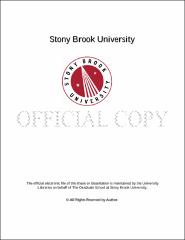| dc.identifier.uri | http://hdl.handle.net/11401/77767 | |
| dc.description.sponsorship | This work is sponsored by the Stony Brook University Graduate School in compliance with the requirements for completion of degree. | en_US |
| dc.format | Monograph | |
| dc.format.medium | Electronic Resource | en_US |
| dc.language.iso | en_US | |
| dc.publisher | The Graduate School, Stony Brook University: Stony Brook, NY. | |
| dc.type | Thesis | |
| dcterms.abstract | On October 29, 2012 Hurricane Sandy hit the south shore of Long Island (NY) causing a major breach on Fire Island. The new influx of ocean water has changed various physical and ecological aspects of Great South Bay (GSB), particularly those areas near the breach. In this study, we measure several environmental variables (salinity, temperature, dissolved oxygen, turbidity, light attenuation, and chlorophyll a) that heavily influence the two seagrass species found in GSB, Zostera marina and Ruppia maritima. Through seagrass and nekton monitoring programs, we quantified the impact of Hurricane Sandy on the flora within the estuarine lagoon, as well as examined temporal and spatial differences in seagrass-associated fauna as a function of a major disturbance event and the proximity to a new oceanic inlet. The most evident water column changes since 2012 have been a drastic bay-wide increase in salinity and a decline in water temperature surrounding the breach area. Dissolved oxygen appears to remain stable after the breach while turbidity, light attenuation, and chlorophyll a varied highly interannually. Loss of Z. marina is evident bay-wide as a direct result of the breach, and data suggests the slow growing species remains at very low percent cover, only able to recover at selective sites across the bay. Ruppia maritima, on the other hand, was not directly impacted by Hurricane Sandy. Although a drastic decline in 2014 was observed, R. maritima has been able to successfully recover. Fauna abundances were significantly higher in 2016 (four years post-Sandy) as compared to 2013, immediately following the breach. Seagrass associated species, such as the pipefish (Syngnathus fuscus), increased in abundance following an increase in seagrass near the breach. Throw trap data suggest that predators presumably moving in and out of the new inlet are impacting the abundance of juvenile blue crabs (Callinectes sapidus) at the sampling site near the inlet. Further monitoring of water quality parameters, flora, and fauna is critical in determining how GSB will ultimately respond to this new influx of ocean water. The value of seagrass as a foundation species is very clear, and effort toward restoration and conservation, while difficult, are of utmost importance. | |
| dcterms.available | 2017-09-20T16:53:32Z | |
| dcterms.contributor | Peterson, Bradley J | en_US |
| dcterms.contributor | Cerrato, Robert M | en_US |
| dcterms.contributor | Roman, Charles T | en_US |
| dcterms.contributor | . | en_US |
| dcterms.creator | Tinoco, Amanda Isabel | |
| dcterms.dateAccepted | 2017-09-20T16:53:32Z | |
| dcterms.dateSubmitted | 2017-09-20T16:53:32Z | |
| dcterms.description | Department of Marine and Atmospheric Science | en_US |
| dcterms.extent | 87 pg. | en_US |
| dcterms.format | Application/PDF | en_US |
| dcterms.format | Monograph | |
| dcterms.identifier | http://hdl.handle.net/11401/77767 | |
| dcterms.issued | 2017-05-01 | |
| dcterms.language | en_US | |
| dcterms.provenance | Made available in DSpace on 2017-09-20T16:53:32Z (GMT). No. of bitstreams: 1
Tinoco_grad.sunysb_0771M_13319.pdf: 2217605 bytes, checksum: 8ee59ab51df5d00483911cbd5465798f (MD5)
Previous issue date: 1 | en |
| dcterms.publisher | The Graduate School, Stony Brook University: Stony Brook, NY. | |
| dcterms.subject | Barrier island breach, Community ecology, Great South Bay, Hurricane Sandy, Ruppia maritima, Zostera marina | |
| dcterms.subject | Ecology -- Biological oceanography | |
| dcterms.title | Effects of Hurricane Sandy on Great South Bay, Long Island: Assessing water quality, seagrass and associated nekton communities | |
| dcterms.type | Thesis | |

